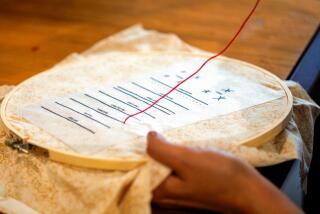AROUND HOME : Counted Cross-Stitch
- Share via
NO DOUBT ABOUT IT, this is the most popular needle craft practiced today. Counted cross-stitch is easy and inexpensive, unlike the previously ultra-popular needlepoint, which is easy and very expensive. Cross-stitch allows the needle worker freedom of expression, too; most designs are now sold as charts rather than as kits, so the stitcher can choose colors and fabric.
Aida cloth is most commonly used by beginners, because its raised woven squares correspond to the squares on a chart. The more confident sewer works on linen or other fine fabrics and counts threads rather than squares. The plain old cross-stitch used in all this is the same one that once appeared on pillows and dresser scarfs in the 1940s and in girlish stitchery samplers as far back as Colonial times (the latter now selling for between $500 and $1,000 each). I remember my mother painstakingly working cross-stitches over tiny printed crosses on a tablecloth, a task I could never master; the printed crosses always seemed to show under the embroidery thread, and most of the designs were uninspired. Counted cross-stitch avoids all that because nothing is printed (unless, of course, you’re working on a kit), and there is an enormous variety of designs available today, from traditional samplers to elaborate florals. Even better: Counted cross-stitch often inspires the experienced practitioner to create her own designs.
Although counted cross-stitch has been around for a long time, it has only taken off in California during the last five years or so. “Our California handcrafts have to be convenient,” says Jina Virtue, one of three owners of Oaks Crossing in Sherman Oaks. “Counted cross-stitch is simple, and you can do a project for under $5.”
It is also the needlework of choice of busy executives. “I wouldn’t think of getting on a plane without counted cross-stitch,” Virtue says.
The many stores offering counted cross-stitch classes and supplies include JB Unique Needlework in Woodland Hills; Lace and Needle Arts in West Hills ; Oaks Crossing in Sherman Oaks ; Willy’s Needleworks in Orange (no scheduled classes, but “I’ll teach ‘em for free,” says Peggy Doyle); The Friend Ship in Pasadena; Debbie’s Needleworks in Torrance; Needle in a Haystack in Glendale, and The Elegant Needle in Villa Park.
Two books, available at needlework shops, recommended by B. J. Hardisty of Debbie’s Needleworks: for beginners, “A Cross Stitch Lesson for Beginners,” by Designs by Gloria and Pat Inc. (authors and publishers), and for the more advanced needleworker, “Linen Stitches,” by Ginnie Thompson, also published by Designs by Gloria and Pat Inc., Sumter, S.C.


